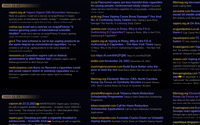
The debate on e-cigarettes is more toxic than e-cigarettes themselves. Public health is genuinely concerned over addiction potentials, and the involvement of corporate/big tobacco. While US tobacco control clings to conjectures and misrepresentations, paralogisms (Think of the children, and flavour fallacy), straight up disinformation (see EVALI), and the obvious repugnance towards public discourse (Bloomberg/WHO).
Rationales seem to vary from prevention-at-all-costs, to XY problem solving, harm/narrative retention, but also genuine misapprehensions. And of course institutional self-preservation, patron courting, or funding displacing ethics.
related
scope
There's never been a harm reduction strategy (seatbelts, methadone, face masks) that wasn't met with hostility. THR opposition however seems motivated beyond ideology and tobacco side hustles. But since armchair diagnosis will go nowhere, this project is about classification firstly. (And providing some quick entry points.)
- It's inevitable to decode some of the common ANTZ arguments again. (figure out common phrases, perhaps trace origins?)
- A text classification model (for press releases mostly; unlikely to work for studies.)
- List some relevant organizations, in particular Bloomberg front groups.
- Political parties are on-topic, if there were attempts at curtailing smoking cessation.
- Note some NGO/TC relations, probable motivations (mostly for benefit of the doubt; it's just observational classification).
- Try to come up with a scoring system on reality/science denial, based on approximation list of sorts.
- Don't put every word on the gold scale for e.g. PAVe or public appearances. But for TI/WHO: do.
project
- See contributing on how to use this site/wiki.
- A mailing-list is yet to be announced.
- Or about for more random notes.
- The news/feed aggregator predates the actual wiki.
- Links are outsourced now to SNW (more difficult to edit, but more accessible)
ToDo
- not-quitting claims,
- marketing-regulations, or lack thereof. (Seems overly convenient that CTFK complaints focus on this, but their US FDA buddies seemingly got deterred from regulating ads & product branding.)
- [junk-scientists] - start table from e.g. brusseltimes open letter
- sniff-tests, risk-communication (functional labels rather than histrionic ones), dual-use, ...


